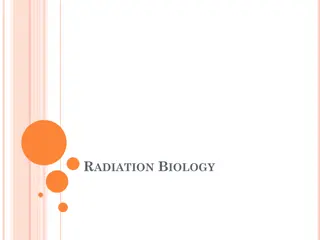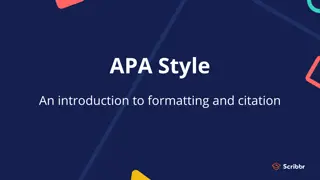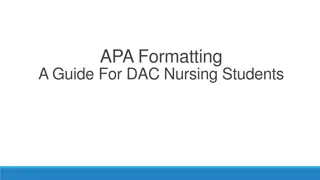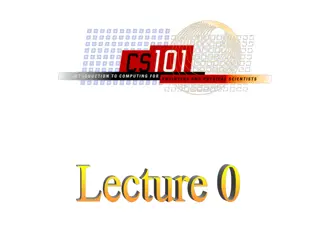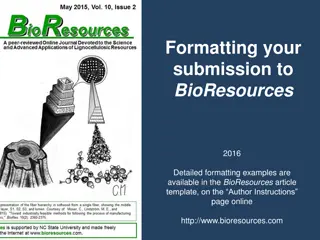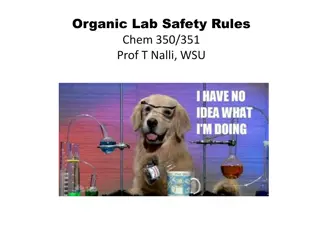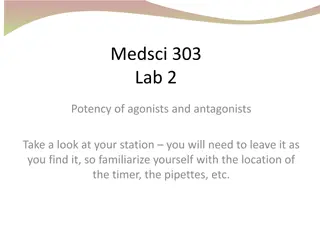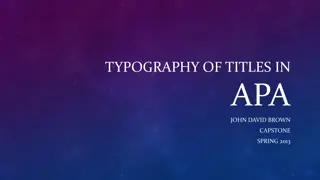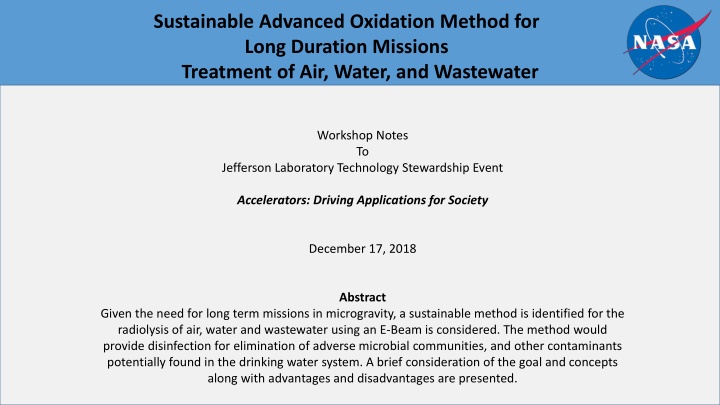
Sustainable Advanced Oxidation Method for Long Duration Missions Workshop Notes
"Explore a sustainable method using E-Beam for treating air, water, and wastewater in long-duration missions, addressing health concerns and maximizing crew health. Consideration of goals, concepts, and advantages of the advanced oxidation method are discussed. References from NASA and dissertation included."
Download Presentation

Please find below an Image/Link to download the presentation.
The content on the website is provided AS IS for your information and personal use only. It may not be sold, licensed, or shared on other websites without obtaining consent from the author. If you encounter any issues during the download, it is possible that the publisher has removed the file from their server.
You are allowed to download the files provided on this website for personal or commercial use, subject to the condition that they are used lawfully. All files are the property of their respective owners.
The content on the website is provided AS IS for your information and personal use only. It may not be sold, licensed, or shared on other websites without obtaining consent from the author.
E N D
Presentation Transcript
Sustainable Advanced Oxidation Method for Long Duration Missions Treatment of Air, Water, and Wastewater Workshop Notes To Jefferson Laboratory Technology Stewardship Event Accelerators: Driving Applications for Society December 17, 2018 Abstract Given the need for long term missions in microgravity, a sustainable method is identified for the radiolysis of air, water and wastewater using an E-Beam is considered. The method would provide disinfection for elimination of adverse microbial communities, and other contaminants potentially found in the drinking water system. A brief consideration of the goal and concepts along with advantages and disadvantages are presented.
Long Duration Missions Potential Health Concern Sources - Characteristics: Emergent or Opportunistic Microbial Communities Erosion / Corrosion / Leaching System products Flora used for long term food source Natural contaminants from off-world sources Contamination from unexpected toxic pollutants (fire) 2
Accepted Goal and Concepts Goal: Maximize Crew Health Essential Sterility (1) Safety System use in microgravity environment Multi-Barrier Approach Disinfectant Monitoring Byproduct management Sustainability Servicing / Maintenance / Reliability Minimal Resupply Reduced Operational Hazards Fate of chemicals and byproducts in the process 3
Advanced Oxidation Method Radiolysis (E-Beam) Ionization Event Reaction on a time scale 10-17 seconds Producing the following radicals: H2O [2.8] OH + [0.62] H + [2.8]e-aq + [0.47]H2 + [0.73]H2O2 + [2.8]H+ Where the [#] = [G] = number of free radicals, molecules / 100 eV (2) Given: A production of oxidants for use in destructing harmful contaminants in an aqueous, solid or air medium and for use as a disinfectant by the push of a button: Disadvantages Advantages Mass Power Shielding Reliable No need for tanks of chemicals Controlled Operation Reduced volume/area needed 4
References (1) Space Station Water Quality Report, Conference Report, NASA-TM-105075, March 1987. (2) Halonitromethane Treatment using Advanced Oxidation Process: Rates, Mechanisms, and Kinetic Modeling, Old Dominion University, Doctoral Dissertation by S. K. Cole, 2005. 5

